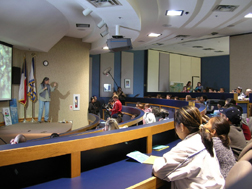Doctoral students Molly Polk and Robert bean have new publications available. Follow the links below for the full text of each article.

Bury, J., Mark, B. G., Carey, M., Young, K. R., McKenzie, J. M., Baraer, M., … Polk, M. H. (2013).
New Geographies of Water and Climate Change in Peru: Coupled Natural and Social Transformations in the Santa River Watershed. Annals of the Association of American Geographers, 103(2), 363–374.
Abstract: Projections of future water shortages in the world's glaciated mountain
ranges have grown increasingly dire. Although water modeling research
has begun to examine changing environmental parameters, the inclusion of
social scenarios has been very limited. Yet human water use and demand
are vital for long-term adaptation, risk reduction, and resource
allocation. Concerns about future water supplies are particularly
pronounced on Peru's arid Pacific slope, where upstream glacier
recession has been accompanied by rapid and water-intensive economic
development. Models predict water shortages decades into the future, but
conflicts have already arisen in Peru's Santa River watershed due to
either real or perceived shortages. Modeled thresholds do not align well
with historical realities and therefore suggest that a broader analysis
of the combined natural and social drivers of change is needed to more
effectively understand the hydrologic transformation taking place across
the watershed. This article situates these new geographies of water and
climate change in Peru within current global change research
discussions to demonstrate how future coupled research models can inform
broader scale questions of hydrologic change and water security across
watersheds and regions. We provide a coupled historical analysis of
glacier recession in the Cordillera Blanca, declining Santa River
discharge, and alpine wetland contraction. We also examine various water
withdrawal mechanisms, including smallholder agriculture, mining,
potable water use, hydroelectric power generation, and coastal
irrigation. We argue that both ecological change and societal forces
will play vital roles in shaping the future of water resources and water
governance in the region.

Lafrenz, M. D., Bean, R. A., & Uthman, D. (2013).
Soil ripening following dam removal. Physical Geography, (ahead-of-print), 1-12.
Abstract: The onset of pedogenesis in dewatered reservoir sediments following a
dam removal was evaluated using a ripening index that was initially
developed to describe the condition of drained, marine sediments behind
Dutch dikes. The drained reservoir exposed lahar terraces, mantled with
reservoir sediment, upstream of the former dam at a similar geomorphic
position to a downstream lahar terrace. Three years following dam
removal, the exposed sediment has physically ripened (
n-values
are less than 0.7) over 1 m to the depth of a buried soil. However, the
sediment has only chemically ripened to a depth of approximately 16 cm,
the depth at which pH values become higher than those of the downstream
terrace soils. Even at the surface, the sediment has not biologically
ripened, as indicated by the low carbon-to-nitrogen ratios (13:1)
relative to those of the downstream soil surface (28:1). These results
indicate that chemical and biological ripening happen more slowly than
physical ripening. As such, dewatered reservoir sediments likely reach
field capacity before other crucial edaphic conditions have developed,
such as the accumulation of plant-available iron and nitrate. This
difference will greatly affect vegetation successional pathways in these
newly created upland environments.
Chang, H., Jung, I.-W., Strecker, A., Wise, D., Lafrenz, M., Shandas, V., Bean, R.,...Paris, M (2013).
Water Supply, Demand, and Quality Indicators for Assessing the Spatial Distribution of Water Resource Vulnerability in the Columbia River Basin. Atmosphere-Ocean, 1–18.
We investigated
water resource vulnerability in the US portion of the
Columbia River basin (CRB) using multiple
indicators representing
water supply,
water demand, and
water quality. Based on the US county scale,
spatial analysis was conducted using various biophysical and socio-economic
indicators that control
water vulnerability.
Water supply vulnerability and
water demand vulnerability exhibited a similar
spatial
clustering of hotspots in areas where agricultural lands and
variability of precipitation were high but dam storage capacity was low.
The hotspots of
water quality vulnerability were clustered around the main stem of the
Columbia River where major population and agricultural centres are located. This multiple equal weight
indicator approach confirmed that different drivers were associated with different
vulnerability maps in the sub-
basins of the CRB.
Water quality variables are more important than
water supply and
water demand variables in the Willamette
River basin, whereas
water supply and
demand variables are more important than
water quality variables in the Upper Snake and Upper
Columbia River basins. This result suggests that current
water resources management and practices drive much of the
vulnerability within the study area. The analysis suggests the need for increased coordination of
water management across multiple levels of
water governance to reduce
water resource vulnerability in the CRB and a potentially different weighting scheme that explicitly takes into account the input of various
water stakeholders.
 I've spent the last two weeks in the field travelling across northern Botswana, in an attempt to understand the landscape from a brown hyena's perspective. Several nights in Nxai Pans and Makgadikgadi National Parks in the east of the country showed me the barrenness of their habitat, driving through miles and miles of grasslands and savannas.I've collected near to 100 GPS points of that area, with corresponding photos, so I'm looking forward to comparing MODIS land cover to actual on the ground images. It was also noticeable that there was near to no natural water to speak of in the area, with all the wildlife clustered either the river or the artificial wells near the cattle posts. There was also a bounty of dead animals by the side of the only tarmac road in the area, a fact the hyenas must also be aware of...
I've spent the last two weeks in the field travelling across northern Botswana, in an attempt to understand the landscape from a brown hyena's perspective. Several nights in Nxai Pans and Makgadikgadi National Parks in the east of the country showed me the barrenness of their habitat, driving through miles and miles of grasslands and savannas.I've collected near to 100 GPS points of that area, with corresponding photos, so I'm looking forward to comparing MODIS land cover to actual on the ground images. It was also noticeable that there was near to no natural water to speak of in the area, with all the wildlife clustered either the river or the artificial wells near the cattle posts. There was also a bounty of dead animals by the side of the only tarmac road in the area, a fact the hyenas must also be aware of...





